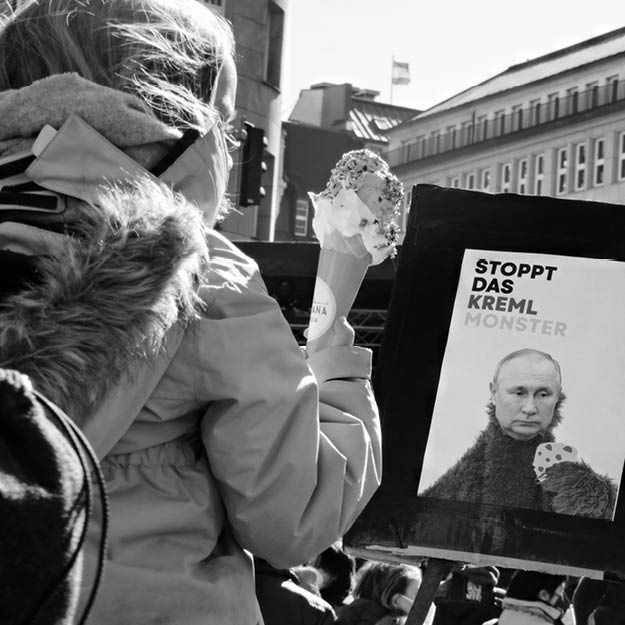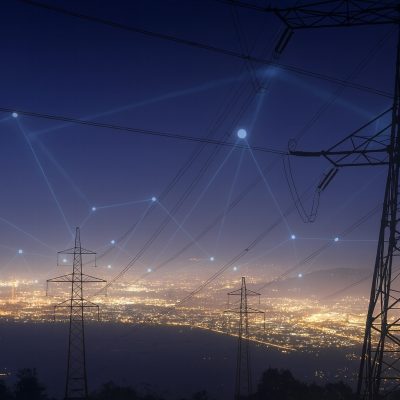Cessons de nourrir l’ours
Plaidoyer en faveur d’un embargo intelligent sur le gaz et le pétrole de Poutine

C’est le 9 mai 1950 que Robert Schuman prononça sa déclaration historique appelant à la création d’une Communauté européenne du charbon et de l’acier. Sa vision politique était claire : faire en sorte que « toute guerre entre la France et l’Allemagne [soit], non seulement impensable, mais matériellement impossible ».
En 2022, si l’Union européenne ne peut pas faire en sorte que toute guerre entre l’Ukraine et la Russie soit impensable, elle peut cependant rendre la guerre de Poutine contre l’Ukraine matériellement impossible. En s’affranchissant des importations d’énergies fossiles russes, l’Union européenne priverait Poutine des fonds dont il a besoin pour financer son effort de guerre.
Cet article se propose de mettre en lumière le contexte géopolitique auquel l’Europe doit faire face avec la seconde invasion de l’Ukraine par Poutine et la façon dont il faudrait adapter la politique énergétique de l’Union européenne pour servir ses buts géopolitiques. Après un bref résumé des trente dernières années de l’histoire ukrainienne, l’article décrit l’état actuel de la guerre. Il explique ensuite le rôle financier des exportations de combustibles fossiles dans l’effort de guerre russe, avant de suggérer qu’un embargo sur les exportations de gaz et de pétrole russes est probablement une issue inévitable, à laquelle nous devons dès à présent nous préparer.
1. Comment l’invasion de l’Ukraine par Poutine est devenue une longue guerre symétrique
L’Empire soviétique s’est effondré en 1991, lorsque le cœur même de l’Empire, la Russie, a déclaré son indépendance. La nation ukrainienne a saisi cette occasion pour renaître de ses cendres. Un référendum sur l’indépendance a été organisé et une immense majorité d’Ukrainiens, dans toutes les régions (oblast) sans exception, y compris la Crimée, Luhansk and Donetsk, a voté en faveur de la création d’un État-nation ukrainien indépendant.
L’indépendance et l’intégrité territoriale de l’Ukraine sont juridiquement affirmées par le Mémorandum de Budapest de 1994, par lequel les États-Unis, le Royaume-Uni et la Fédération de Russie s’engagent à « respecter l’indépendance et la souveraineté ukrainiennes dans ses frontières actuelles ».
Vingt ans plus tard, l’un des signataires a violé le traité. La Russie de Poutine envahi et annexe la Crimée, la première annexion d’un territoire en Europe depuis la fin de la seconde guerre mondiale. L’armée russe mène depuis 8 ans une guerre dans le Donbass. Le 24 février 2022, Vladimir Poutine a envahi l’Ukraine une seconde fois, à bien plus grande échelle.
Au début de la crise, la plupart des analystes militaires s’attendaient à une guerre dissymétrique : deux armées post-soviétiques combattant avec des équipements et des doctrines similaires, l’une des parties (la Russie) étant cependant beaucoup plus puissante que l’autre (l’Ukraine). La défaite de l’Ukraine ne devait dès lors être qu’une question de jours. Aujourd’hui, après plus de deux mois et avec des victoires ukrainiennes à Kiev, Chernihiv et Suomi, et des victoires russes à Kermina, Kherson et Marioupol, la guerre ne semble plus asymétrique. Elle ressemble plutôt à une guerre symétrique.
Les guerres symétriques peuvent durer des années. Elles prennent fin lorsque l’une des parties réussit à prendre un avantage décisif ou lorsque les deux parties sont si épuisées qu’elles abandonnent toutes les deux.
Dans ce contexte de guerre symétrique, en supposant que l’Union européenne veuille garantir l’intégrité territoriale et la souveraineté de l’Ukraine, tout en évitant une confrontation militaire directe avec la Russie, quelles sont les conditions nécessaires pour se donner une chance d’y parvenir ? Ce scénario inclut une victoire militaire de l’Ukraine sur les forces de Poutine. Pour atteindre cet objectif, il faut que la guerre symétrique devienne dissymétrique, mais en faveur de l’Ukraine cette fois. Ce retournement passe par l’intensification des politiques nationales et communautaires déjà existantes pour apporter une aide financière et fournir des équipements militaires à l’Ukraine. L’Union européenne devrait en outre se doter des moyens d’affaiblir suffisamment Poutine pour créer de l’dissymétrie sur le champ de bataille. C’est ici que les enjeux énergétiques deviennent centraux.
2. L’invasion de l’Ukraine par Poutine est aussi une guerre des hydrocarbures
L’économie russe est fragile, c’est l’un des talons d’Achille de Poutine. Son produit intérieur brut (PIB) est comparable à celui de l’Espagne, alors que la Russie est trois fois plus peuplée. Le PIB russe par habitant est comparable à celui de la Bulgarie, l’État membre le plus pauvre de l’Union européenne. L’économie russe repose sur l’exportation de matières premières non transformées, le pétrole brut et le gaz fossile notamment. La Russie ne possède, ni les grandes entreprises diversifiées que l’on trouve en France, ni la puissante base industrielle italienne, ni le solide mittelstand allemand, ni les sociétés à la pointe de l’innovation que l’Estonie a développées.
On peut résumer le complexe militaro-énergétique russe en trois chiffres : un PIB russe de 1 500 milliards d’euros, des exportations de combustibles fossiles russes vers l’Union européenne qui génèrent jusqu’à 250 milliards d’euros et un budget militaire russe qui représente 60 milliards d’euros.
La conclusion est simple : la guerre de Poutine en Ukraine est une guerre des hydrocarbures. C’est la dépendance de l’Europe au gaz et au pétrole russes qui donne à Poutine les moyens matériels de mener cette guerre. Pour simplifier à l’extrême : plus d’argent provenant des hydrocarbures, plus de guerre. Pour autant, il faut du temps pour que des sanctions économiques exercent tout leur impact. Interrompre aujourd’hui les flux financiers liés aux combustibles fossiles entre l’Union européenne et la Russie ne mettra pas immédiatement un terme à la guerre, mais soumettra Poutine à une pression croissante qui finira par imposer des contraintes à l’armée russe. En dépit du poids potentiel de ces sanctions, la proposition la plus ambitieuse de l’Union européenne jusqu’à présent se borne à cesser progressivement la plupart des importations de pétrole russe d’ici la fin 2022, et éventuellement de cesser progressivement les importations de gaz russe à l’horizon 2027. Pourquoi agir si lentement ?
3. Comment les Européens ont choisi de devenir dépendants des combustibles fossiles russes
La dépendance de l’Union européenne aux combustibles fossiles est la conséquence de choix politiques. Contrairement à la croyance populaire, la source d’énergie de la première révolution industrielle européenne n’était pas le charbon, mais les énergies renouvelables. C’est l’énergie hydraulique qui a alimenté les débuts de l’industrie textile en Europe. Cette industrie tirait ses matières premières du travail humain. Les matières premières et les produits finaux étaient expédiés dans toute l’économie déjà mondialisée du 19e siècle à l’aide d’une autre énergie renouvelable : le vent qui gonflait les voiles des navires de commerce.
Ce n’est qu’avec les 2e et 3e révolutions industrielles que le charbon, le pétrole et le gaz sont devenus les principales sources d’énergie. Cette évolution est le résultat d’une multitude de décisions politiques qui ont eu pour effet d’ancrer dans la durée de profonds choix socio-techniques. Ces choix ont abouti au système énergétique européen moderne, qui repose sur un gaspillage et un usage inefficient de vastes quantités de combustibles fossiles.
Au début, les empires européens avaient recours aux combustibles fossiles nationaux. Le charbon était abondant en Allemagne. Le pétrole était abondant dans l’Empire britannique. Le gaz était abondant aux Pays-Bas. Pourtant, des décennies d’épuisement des ressources, la hausse de la demande en énergie et la décolonisation ont conduit les Européens à se tourner vers l’énergie russe. Cette dépendance a été accentuée par vingt ans de coopération gazière entre l’Allemagne et la Russie, qui a trouvé son aboutissement dans la création du gazoduc Nord Stream 1, ainsi que par le soutien que le gouvernement allemand a continué d’apporter au gazoduc Nord Stream 2, malgré l’annexion de la Crimée en 2014, la guerre dans le Donbass et l’opposition de l’Union européenne à ce projet.
En 2019, environ 25 % de l’énergie consommée en Europe provenait de Russie. L’introduction d’un embargo sur les combustibles fossiles russes équivaut par conséquent à ramener notre dépendance à l’énergie russe d’un quart à zéro.
4. Agir aujourd’hui comme si un embargo était inévitable : sobriété, efficacité énergétiques, énergies renouvelables et diversification.
Nous devons agir aujourd’hui comme si un embargo sur le gaz et le pétrole russes était inévitable. C’est en effet le cas le plus probable. La schizophrénie morale des leaders européens, qui d’un côté prétendent soutenir l’Ukraine et se disent horrifiés par les crimes de guerre de Poutine, tout en versant d’un autre côté des milliards d’euros (ou de roubles) en espèces au même Vladimir Poutine, lui donnant ainsi les moyens matériels de mener sa guerre et de commettre ses crimes de guerre, est moralement intenable. Qui plus est, nous vivons à présent sous l’épée de Damoclès du chef du Kremlin, qui menace tous les États membres de l’Union européenne de couper la fourniture de gaz, comme il l’a déjà fait pour la Pologne et la Bulgarie le 27 avril 2022. Cependant, quelles mesures spécifiques devons-nous prendre ?
Le 8 mars, la Commission européenne a publié sa communication REPowerEU. Après plusieurs décennies de procrastination, cette communication semble aborder quelques thèmes avec ambition, les pompes à chaleur par exemple. Elle fait cependant preuve de frilosité au regard de ce que nous devons faire, tant pour assurer la paix de notre temps que pour éviter le chaos climatique. Elle contient par ailleurs de nombreux angles morts, sur la sobriété énergétique, la rénovation des bâtiments et le développement des technologies propres. Alors que la Commission actualise son plan le 18 mai, un bon point de départ serait de réfléchir à comment nous pouvons nous hisser à la hauteur de l’Histoire.
Inspirons-nous d’une récente montée en puissance massive : le dépistage de la COVID 19. Depuis mars 2020, nous sommes passés d’une capacité très faible, ne permettant de réaliser pratiquement qu’un seul type de test, à la capacité d’administrer des millions de différents types de tests tous les jours en Europe. Cette montée en puissance n’est pas le fait d’une main invisible mais le résultat d’une mobilisation générale de toute la société. Des individus qui choisissent de réaliser les tests aux pharmaciens qui les administrent. Des laboratoires qui analysent les résultats aux développeurs qui mettent au point des plateformes numériques pour les centraliser et les distribuer. Enfin et surtout, les sociétés innovantes qui ont créé un portefeuille de solutions de dépistage de la COVID 19. Aujourd’hui, nous avons besoin d’une mobilisation générale similaire de la société, pour être à même de monter en puissance dans les semaines, les mois et les années qui viennent. Transposée au système de l’énergie, cette mobilisation générale s’articule autour de quatre axes complémentaires : sobriété énergétique, efficacité énergétique, énergies renouvelables et diversification.
La sobriété énergétique d’abord ! Assurer notre sobriété énergétique consiste à réduire notre demande en énergie en modifiant nos comportements individuels et collectifs. En prenant la campagne japonaise d’économie d’énergie (Setsuden) de 2011 comme référence, on observe que les campagnes de grande ampleur en faveur de la sobriété énergétique ont le potentiel de réduire immédiatement la demande d’environ 15 %. Certaines mesures en faveur de la sobriété énergétique sont aussi banales et indolores que le lavage des mains pour lutter contre la COVID : porter un pull en hiver pour faire des économies de chauffage ou cesser de gaspiller de l’énergie pour chauffer les terrasses de café. D’autres seront aussi douloureuses qu’un test COVID nasal : réduire les limitations de vitesse sur les routes d’au moins 10 km/h ou choisir d’effectuer un voyage de 6 heures en train au lieu d’un voyage de 3 heures en taxi-avion-taxi. Pour terminer, certaines mesures peuvent être prises par les plus favorisés de nos sociétés, sans être imposées aux plus faibles : les adultes en bonne santé peuvent chauffer leur domicile sans dépasser 16° C, et les plus riches peuvent délaisser leurs voyages d’agrément bi-mensuels en avion pour un tourisme ferroviaire local pendant les deux prochaines années. En l’espèce, le défi est purement politique. La Commission européenne devrait faire partie de la solution à ce dilemme politique, au moins en mettant en valeur les meilleures pratiques que les pays ont mises en œuvre au cours de l’histoire, y compris les pays d’Europe de l’Ouest après le premier choc pétrolier.
Pourtant, même avec des campagnes ambitieuses en faveur de la sobriété énergétique, nous sommes loin de l’objectif de devenir entièrement indépendants des combustibles fossiles russes. C’est ici que l’efficacité énergétique et les énergies renouvelables entrent en jeu.
L’efficacité énergétique est vitale pour la sécurité énergétique de l’Europe. L’Union européenne a réussi à réduire sa demande en énergie de 10 % (2006-2019), et importe dès lors moins d’énergie de l’étranger. Elle aurait cependant dû faire davantage. Une étude récente de l’Iddri montre que, si la France avait réussi à mettre en œuvre ses plans nationaux de rénovation des bâtiments, elle aurait suffisamment réduit sa consommation de gaz pour s’affranchir dès aujourd’hui entièrement du gaz russe. La rénovation globale d’un bâtiment réduit sa consommation d’énergie de 60 à 90 %.
C’est la même chose pour les énergies renouvelables, la chaleur renouvelable notamment, le concurrent le plus direct du gaz fossile dans le secteur du chauffage. Les solutions efficaces de chauffage à base de biomasse, le chauffage solaire et les pompes à chaleur sont tous des systèmes de chauffage renouvelable qu’il est possible de déployer rapidement pour réduire la consommation de gaz de l’Union européenne. Dans une moindre mesure, c’est aussi le cas pour l’électricité renouvelable : tous les nouveaux panneaux solaires ou éoliennes qui produisent de nouveaux électrons remplacent des électrons qui auraient été produits par une centrale à gaz.
L’avantage des actions en faveur de l’efficacité énergétique et des énergies renouvelables est qu’elles sont rapidement déployables au niveau local. Il ne faut que deux heures pour faire vérifier l’efficience de son système de chauffage. Deux jours pour installer une pompe à chaleur. Deux semaines pour rénover un bâtiment en profondeur, avec la démarche EnergieSprong.
L’inconvénient est qu’il faut des mois et des années pour déployer l’efficience énergétique et les énergies renouvelables à grande échelle. Par conséquent, l’Europe devrait aujourd’hui se fixer comme toute première priorité de rénover autant de bâtiments chauffés au fioul et au gaz, et d’installer autant d’énergies renouvelables, que possible, avant l’arrivée de l’hiver, puis chaque année. Ces mesures aident à soulager la pression exercée par les prix élevés du pétrole, du gaz et de l’électricité et protègent les Européens contre les catastrophes causées par le changement climatique en réduisant les émissions de gaz à effet de serre.
Enfin, la sobriété et l’efficacité énergétiques et les énergies renouvelables ne seront probablement pas déployées assez vite et à une échelle suffisante pour permettre aux Européens de s’affranchir entièrement et immédiatement des combustibles fossiles russes. Pour conclure, nous avons besoin d’un degré de diversification capable de remplacer les combustibles fossiles russes par des combustibles fossiles non russes. Alors que cette option stratégique s’est imposée dans l’élaboration des politiques publiques, y compris la communication de la Commission européenne visée plus haut, il faut souligner qu’elle représente l’option la plus coûteuse et la plus polluante et qu’il convient donc de n’y recourir qu’en tout dernier ressort.
Certaines mesures en faveur de la diversification peuvent se révéler dommageables, en étant coûteuses pour notre économie et nuisibles pour notre avenir, comme la décision actuelle du gouvernement allemand de construire de nouveaux terminaux de gaz naturel liquéfié (GNL) pour permettre aux importateurs allemands de surenchérir sur les importateurs asiatiques qui ont l’intention de passer de la génération d’électricité au charbon à la génération d’électricité au gaz. Jusqu’à présent, la plupart des débats politiques se sont focalisés sur cette prétendue diversification, en oscillant entre Charybde et Scylla, à un coût pour l’économie de l’Union européenne qui sera aussi douloureux que les prix du GNL sont élevés. Une certaine diversification est cependant envisageable en procédant avec intelligence, en cohérence avec nos objectifs géopolitiques et climatiques. Il serait par exemple possible d’élaborer entre l’Union européenne et l’Algérie un Green Deal qui verrait l’Algérie déployer des panneaux solaires en masse pour réduire sa consommation de gaz. Au lieu d’utiliser son gaz pour produire de l’électricité, l’Algérie pourrait le vendre aux pays d’Europe méridionale, centrale et orientale (Italie, Grèce, Bulgarie).
5. Comptes séquestres : se préparer à un embargo total, tenter de mettre en oeuvre un embargo intelligent
Avec une mobilisation générale autour de la suffisance et de l’efficience énergétiques, des énergies renouvelables et d’une diversification raisonnable vers des combustibles fossiles non russes, l’Europe sera prête pour un embargo total sur le gaz et le pétrole russes.
Un tel embargo total s’accompagne cependant de retombées négatives et il n’est pas inutile de rechercher des moyens qui pourraient permettre à l’Europe de continuer d’importer de l’énergie russe tout en privant Poutine de l’argent des hydrocarbures. Il est possible d’y parvenir en ayant recours à des comptes séquestres. Quel en serait le mode de fonctionnement ? L’Union européenne imposerait des sanctions sur les banques de l’industrie gazo-pétrolière russes et demanderait aux importateurs européens de continuer de payer leurs importations, sur un compte bancaire spécialement créé à cet effet et gelé. Les fonds resteraient sur ce compte tant que les sanctions de l’Union européenne sont en place. Les milliards s’accumuleraient sur les comptes gelés, privant Poutine de l’argent dont il a besoin pour mener sa guerre.
Le principal inconvénient de ce type d’embargo intelligent est que Vladimir Poutine pourrait répondre en imposant un embargo total et cesser les exportations d’énergie russes vers l’Union européenne. L’Union européenne doit dès lors d’ores et déjà mettre en place toutes les mesures dont elle dispose en faveur de la suffisance et de l’efficience énergétiques, des énergies renouvelables et de la diversification pour atténuer les impacts d’un tel embargo total sur l’économie et la société européennes. En d’autres termes : se préparer au pire (embargo total), planifier le meilleur (embargo intelligent).
Conclusion
La guerre est de retour sur le continent. Des milliers d’Ukrainiens meurent pour défendre leur liberté. Malgré les agressions et les crimes de guerre de l’armée russe, les Européens continuent de financer la guerre de Poutine en Ukraine en lui achetant son gaz et son pétrole. Cette situation met en lumière les immenses risques géopolitiques que provoque la dépendance de l’Union européenne aux combustibles fossiles.
Nous pouvons nous affranchir de notre dépendance aux énergies fossiles russes. Pour y parvenir, nous devons lancer une mobilisation générale des sociétés, citoyens, travailleurs, entreprises et États européens en faveur de comportements propices à la sobriété et à l’efficacité énergétiques et aux investissements dans les énergies renouvelables. Il convient de compléter ces mesures par une diversification raisonnable vers les combustibles fossiles non russes. Toutes ces interventions préparent l’Europe à surmonter un embargo complet.
Un embargo immédiat n’est pas dans l’intérêt énergétique de l’Europe. Il n’est dès lors pas inutile de tenter d’introduire un embargo intelligent basé sur un système de comptes séquestres. Cette solution parviendrait aux mêmes résultats géopolitiques (à savoir, priver Poutine des moyens matériels de mener avec succès une guerre longue en Ukraine), tout en évitant le pire impact sur l’Europe (c’est à dire la fin des flux physiques de gaz et de pétrole russes vers l’Europe). Au cours du Conseil européen du 30-31 mai, les chefs d’État et de gouvernement devraient tenter de parvenir à un compromis en faveur de la mise en œuvre immédiate d’un système de comptes séquestres, tout en continuant d’aller de l’avant avec la proposition de la Commission européenne du 4 mai en faveur d’un embargo progressif sur le pétrole, devant entrer pleinement en vigueur d’ici la fin 2022 pour la plupart de l’Union et en 2023 pour la Hongrie et la Slovaquie.
Dans le pire des cas, un embargo total contraindrait les Européens à accélérer ce qu’ils ont déjà prévu de faire pour aider à sauver notre monde du chaos climatique. Dans le meilleur des cas, une décision stratégique européenne décisive en matière d’énergie permettra probablement d’épargner des milliers de vies russes et ukrainiennes en mettant plus rapidement un terme à la guerre. Ce serait également une occasion de réconcilier les Européens autour de la notion de Green Deal et du projet y associé. Les enjeux climatiques, tout incontestables qu’ils soient, rencontrent davantage l’adhésion chez les Européens les plus jeunes, femmes, occidentaux et politiquement proche de la gauche. La seconde invasion de l’Ukraine par Poutine, quant à elle, nous rappelle l’importance de l’enjeu de sécurité nationale, qui était un des des premières tentatives politiques de l’Union de l’énergie. Ce principe est généralement mieux accueilli parmi les Européens plus âgés, hommes, politiquement proche de la droite et issus des pays d’Europe de l’Est. Chacun de nos actes en faveur de la sobriété et de l’efficacité énergétiques et des énergies renouvelables aboutit à un résultat, tant sur le plan du climat que sur celui de la sécurité. En proposant une mobilisation générale autour de ces axes majeurs, la communication de la Commission européenne sur les économies d’énergie prévue le 18 mai a le potentiel pour faire passer un message unique qui parlera à presque toutes les Européennes et Européens. Elle peut montrer comment le Green Deal européen est aujourd’hui une composante existentielle d’un projet d’intégration européen bâti sur la paix et la liberté.




